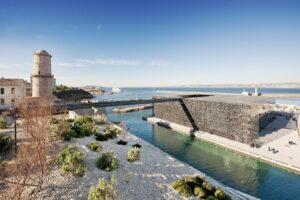Fodor's Expert Review Palais des Papes
This colossal palace creates a disconcertingly fortresslike impression, underlined by the austerity of its interior. Most of the original furnishings were returned to Rome with the papacy; others were lost during the French Revolution. Some imagination is required to picture the palace's medieval splendor, awash with color and with worldly clerics enjoying what the 14th-century Italian poet Petrarch called "licentious banquets." On close inspection, two different styles of building emerge at the palace: the severe Palais Vieux (Old Palace), built between 1334 and 1342 by Pope Benedict XII, a member of the Cistercian order, which frowned on frivolity, and the more decorative Palais Nouveau (New Palace), built in the following decade by the artsy, lavish-living Pope Clement VI. The Great Court, entryway to the complex, links the two.
The main rooms of the Palais Vieux are the Consistory (Council Hall), decorated with some excellent 14th-century frescoes by Simone Martini; the Chapelle... READ MORE
This colossal palace creates a disconcertingly fortresslike impression, underlined by the austerity of its interior. Most of the original furnishings were returned to Rome with the papacy; others were lost during the French Revolution. Some imagination is required to picture the palace's medieval splendor, awash with color and with worldly clerics enjoying what the 14th-century Italian poet Petrarch called "licentious banquets." On close inspection, two different styles of building emerge at the palace: the severe Palais Vieux (Old Palace), built between 1334 and 1342 by Pope Benedict XII, a member of the Cistercian order, which frowned on frivolity, and the more decorative Palais Nouveau (New Palace), built in the following decade by the artsy, lavish-living Pope Clement VI. The Great Court, entryway to the complex, links the two.
The main rooms of the Palais Vieux are the Consistory (Council Hall), decorated with some excellent 14th-century frescoes by Simone Martini; the Chapelle St-Jean, with original frescoes by Matteo Giovanetti; the Grand Tinel, or Salle des Festins (Feast Hall), with a majestic vaulted roof and a series of 18th-century Gobelin tapestries; the Chapelle St-Martial, with more Giovanetti frescoes; and the Chambre du Cerf, with a richly decorated ceiling, murals featuring a stag hunt, and a delightful view of Avignon. The principal attractions of the Palais Nouveau are the Grande Audience, a magnificent two-nave hall on the ground floor, and, upstairs, the Chapelle Clémentine, where the college of cardinals once gathered to elect the new pope. To get the most out of the experience, consider a €2 audio tour.
READ LESS





